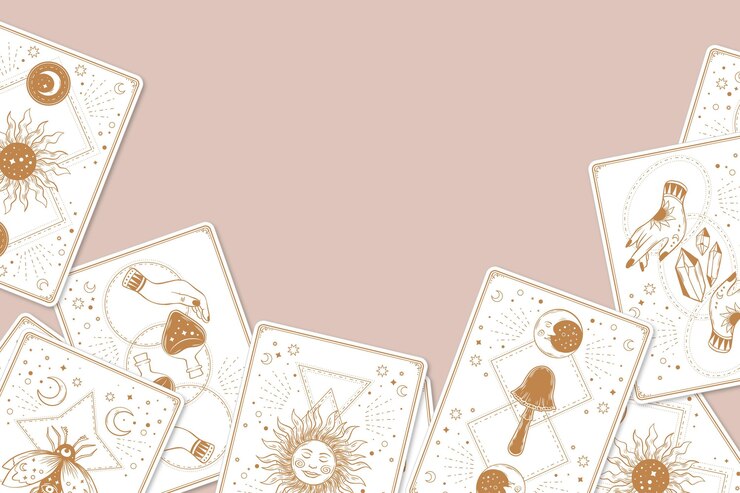
Tarot card reading, a fusion of ancient wisdom and contemporary insight, involves unraveling the symbolism within the cards to glean profound insights into the past, present, and future. As we delve into the realms of Tarot card meanings, Major and Minor Arcana, symbolism, and personalized spreads, this guide will empower you to unlock the profound mysteries concealed within the Tarot’s captivating imagery.
1. Understanding Tarot Card Meanings
With their enigmatic allure, tarot cards bear witness to centuries of human curiosity and introspection. Originating in 15th-century Europe as mere playing cards, they metamorphosed into a profound instrument for divination and self-reflection. These cards, steeped in history, have transcended their humble beginnings to become gateways to the mystical and unknown.
Tarot cards encompass the Major Arcana, a symbolic journey through life’s profound experiences, and the Minor Arcana, reflecting the day-to-day facets of existence. Let’s check out the meaning of both these Arcana in brief.
The Major Arcana: Unlocking the Journey of the Fool
The Major Arcana, a set of 22 cards, symbolizes profound life experiences. They carry archetypal significance, ranging from The Fool’s innocence to The World’s completion. Key cards like The Fool, The Magician, and The High Priestess hold unique meanings – the Fool signifying new beginnings, the Magician empowerment, and the High Priestess intuition. The Fool’s Journey, a narrative through these cards, mirrors personal growth, resilience, and transformative wisdom, making the Major Arcana a guide for self-discovery and understanding life’s journey.
The Minor Arcana: Unveiling the Everyday Aspects of Life
The Minor Arcana, divided into suits (Wands, Cups, Swords, Pentacles) and court cards, captures the nuances of daily existence. Each suit corresponds to an element – Wands (fire), Cups (water), Swords (air), Pentacles (earth) – influencing interpretations. Dive into the journey from Ace to Ten within each suit, unraveling insights into action, emotions, intellect, and material aspects. The court cards (Page, Knight, Queen, King) personify different personalities and roles, adding depth to readings and reflecting diverse facets of human experience.
2. Exploring Tarot Card Symbolism and Combination
Tarot cards are rich in symbolism, including elements (fire, water, air, earth), animals, and numbers. Elements convey energies, animals represent archetypal traits, and numbers hold numerological significance, creating a symbolic language that transcends cultural boundaries. Interpreting symbols involves considering their context, relationships, and personal connections.
For instance, a lion might signify courage or passion, and its presence in a card could indicate these qualities. Integrating symbols enhances the depth and precision of Tarot readings, allowing for nuanced insights and a deeper connection with the cards.
Likewise, understanding card combinations is crucial in tarot readings, as it adds layers to the narrative. Cards interact dynamically, influencing each other’s meanings. For instance, pairing The Lovers with The Tower may suggest sudden changes in a relationship. Exploring common combinations enhances readers’ ability to weave a cohesive story, offering profound insights beyond individual card meanings.
3. Numerology and Tarot: Numbers Speak Volumes
Numerology plays a vital role in Tarot, enhancing the depth of card meanings. Each number carries its unique vibration, contributing to the overall message of the card and influencing its interpretation within a reading. The numbers on Tarot cards offer additional layers of meaning, providing insights into cycles, energies, and spiritual significance. Understanding the numerology of a card enriches the interpretation, offering a more comprehensive understanding of its relevance to the querent’s situation.
Exploring Number Meanings in Tarot
By delving into numerology, Tarot readers can unlock a deeper level of symbolism, allowing for a more profound exploration of the spiritual and energetic aspects embedded within the cards.
- The Ace (1): Signifying new beginnings, potential, and singular focus.
- The Three (3): Representing growth, collaboration, and creativity.
- The Ten (10): Symbolizing completion, fulfillment, and the end of a cycle.
Know more: Tarot and Astrology: Understanding the Cosmic Connection in Your Readings
4. Tarot Card Spreads for Meaningful Readings
Explore foundational spreads like the versatile three-card spread for quick insights and the elaborate Celtic Cross spread for a comprehensive reading. Each spread serves a unique purpose, catering to various questions and scenarios.
Step-by-step Guide on Tarot Card Reading
From shuffling the deck to interpreting cards within selected spreads, this guide ensures a structured and insightful reading experience.
Shuffling the Deck
Begin by thoroughly shuffling the tarot deck to infuse your energy and intentions. This process enhances the connection between the reader, the querent, and the cards, creating a personalized experience.
Drawing the Cards
Focus on the question or intention while drawing cards. Select the designated number of cards depending on the chosen spread, ensuring a deliberate and mindful approach to each draw.
Card Placement
Understand the designated positions within the chosen spread. Each position holds a unique significance, guiding the interpretation. Common positions include past, present, future, and internal/external influences.
Interpreting the Cards
Engage in a thoughtful analysis of each card’s symbolism, considering its position and relation to neighboring cards. Explore both individual meanings and the collective story emerging from the combination.
Noting Reversals
Take note of any reversed cards and incorporate their unique meanings. Reversed cards often add depth, suggesting challenges, delays, or internal conflicts contributing to the narrative.
Considering Card Relationships
Analyze how adjacent cards interact. Cards influence each other, creating a nuanced storyline. A positive card beside a challenging one may indicate overcoming obstacles or finding balance.
Weaving a Narrative
Piece the interpreted cards together into a cohesive narrative addressing the querent’s question or situation. Consider the flow of the reading, emphasizing key points and insights.
Providing Insightful Guidance
Conclude the reading by offering insightful guidance based on the collective meaning of the cards. Connect the interpreted symbols to the querent’s life, fostering clarity and empowering them to navigate their journey.
Learn: Demystifying Tarot: Separating Tarot Myths From Fact
5. Reversed Tarot Cards: Flipping Perspectives
In tarot readings, reversed cards occur when drawn upside down. They introduce a unique layer of meaning, contrasting with the upright interpretation and often signaling challenges, delays, or internal conflicts. Reversed cards inject complexity into readings, offering a more nuanced perspective. They encourage exploration of obstacles, unresolved issues, or hidden aspects, enriching the narrative with a deeper understanding of the querent’s situation.
Tips on Interpreting Reversed Cards
Understanding reversed tarot cards enhances the depth of readings, fostering a holistic interpretation that acknowledges both the light and shadow aspects of the querent’s journey.
- Consider Opposites: Delve into the opposite of the card’s upright meaning to uncover potential challenges or contrasts.
- Reflect on Internal Conflicts: Reversed cards may indicate internal struggles or unresolved emotions. Explore the querent’s inner landscape for a comprehensive understanding.
- Explore Blocked Energy: Reversed cards can suggest blocked energy or stalled progress. Consider areas where the querent may be facing resistance or obstacles.
- Reevaluate Surrounding Cards: Analyze neighboring cards to discern how the reversed card interacts with its surroundings. This contextual approach helps in understanding the specific nuances of the reversal.
Read: The Art of Tarot Reading: Mastering the Techniques for Accurate Readings
Final Thoughts
As we conclude this journey into the intricate world of Tarot card meanings, we must recognize that our exploration is but a step in an ongoing, evolving journey. The cards’ symbolism, numerology, and rich tapestry continue to unveil new insights, offering a perpetual source of wisdom for those willing to delve deeper.
Let this be an encouragement – an invitation to approach Tarot with an open mind and boundless curiosity. Embrace the journey of self-discovery & transformation that Tarot cards uniquely offer. With their timeless symbolism, the cards have the power to guide, inspire, and illuminate.
However, in the pursuit of understanding Tarot, consider seeking guidance from professional Tarot card experts. Their expertise and intuitive insight can provide accurate and nuanced interpretations, enhancing your exploration and ensuring a more profound connection with the mysteries contained within the cards. May your Tarot journey be filled with revelation, wisdom, and the endless possibilities the cards hold.
Recent Posts

Angel Numbers Ending in 11: Signs of Love, Growth, and Alignment
Olivia Marie Rose | March 29, 2025

Sagittarius Woman Traits, Personality & Love Style: A Full Guide
Aryan K | March 29, 2025

Aquarius Birthstone: Top Crystals and Their Healing Powers
Aryan K | March 29, 2025

December 25 Zodiac Sign: Traits of a True Capricorn
Aryan K | March 29, 2025

Find the Best Gemstones for Astrological Signs: A Comprehensive Guide
Aryan K | March 28, 2025
Topics
- 4 Digit Angel Numbers
- 5 Digit Angel Numbers
- 6 Digit Angel Numbers
- Astrology and Birth Charts
- Business Astrology
- Career Astrology
- Celebrities and Personalities Astrological Profile
- Children Astrology
- Chinese Astrology
- Different Angel Numbers Meaning
- Double Digit Angel Numbers
- Dreams Interpretation
- Festivals
- Finance Astrology
- Find Baby Names
- Find Best Astrologers
- Gemstones and Birthstones
- Janam Kundli Chart
- Love Astrology
- Marriage Prediction Astrology
- Nakshatra (Constellations)
- Numerology
- Pet Astrology
- Rudraksha Beads
- Single Digit Angel Numbers
- Spirit Animals
- Spirituality and Positivity
- Stars, Planets and Cosmic
- Symbolism
- Tarot Cards
- Triple Digit Angel Numbers
- Understanding Hinduism
- Vastu Shastra
- Vedic Astrology
- Western Astrology
- Yoga and Meditation
- Zodiac Sign Date Calendar
- Zodiac Signs
- Zodiac Signs Compatibility
